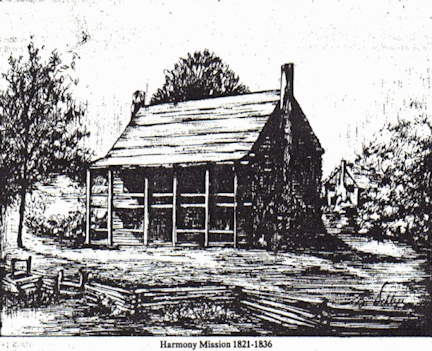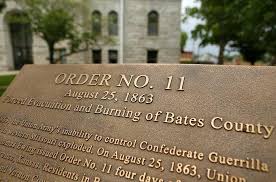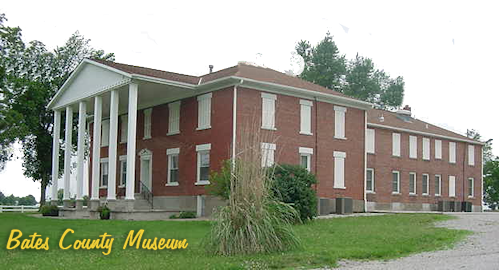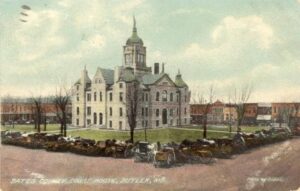Bates County History
County: Bates
Organized: January 29, 1841
County Seat: Butler
Bates County was named in honor of Frederick Bates, the second governor of Missouri, who died in office August 14, 1825. Missionaries from New York settled the first community in Bates County, Harmony Mission, for the purpose of educating Indians. When Bates County organized and separated from Cass County in 1841, county commissioners selected Harmony Mission as the first county seat, presumably because of the established development and central location.
After first meeting in a private home, subsequent courts met in the Mission House until 1847 when the county seat moved to Papinville, three miles southeast of Harmony Mission.
Orders for building the first courthouse, at Papinville, came in November 1852, when the court appointed Freeman Barrows superintendent and appropriated $2,500. The following month Barrows submitted a plan and the court accepted bids. But, in August 1853 Abraham Redfield replaced Barrows as superintendent and produced plans and specifications prepared by Fritzpatrick and Hurt from Benton County (Fritzpatrick’s name also appears as Fitzpatrick.) The court appropriated $4,200 for the 35-by-60-foot brick building. It was completed in 1855. After 1856, when the county seat moved to Butler, Philip Seal bought the courthouse and converted it to business use. Destruction by fire came in 1861, during the Civil War.
In 1855, after an area separated to become Vernon County, Papinville was no longer near the geographic center of Bates County. The original plan for dividing Butler’s land into building lots, commonly called a plat, was filed and recorded in August 1853. Fifty-five acres donated to the county induced officials to move the county seat to Butler in 1856. The court ordered 50-by-50-foot brick courthouse at an estimated cost of $5,000. Fritzpatrick and Hurt again served as contractors. This building, too, burned in 1861.
Because of the attack on Lawrence, Kansas by Missouri guerrillas, on August 25, 1863 the infamous Order #11 was issued by General Thomas Ewing [click on these websites Missouri and the Civil War and GENERAL ORDER for more details]. This order forced all residents of Bates and Cass Counties to vacate their homes within 15 days. Bates County was put to the torch as Missouri endured 1,100 of the 6,600 engagements and battles fought in the Civil War. During this time courts were held in locations other than the county seat. In May 1864 the court met at Johnstown. The legislature recognized Pleasant Gap as the official county seat in 1865, and the sheriff was ordered to prepare a clerk’s office and courtroom.
.gif)
 At the end of the Civil War, Bates County citizens returned to find burnt out structures, a devastated county seat and desolate land. At the November 1865 term, the court appropriated $750 for clerk’s office and courthouse. The courthouse was to measure 16 by 24 feet, the clerk’s office 16 feet square, and both 10 feet high. Later appropriations raised the sum to $1,100. John D. Meyers, county clerk, served as superintendent, and the court authorized him to select the location for this interim courthouse. Old settlers recalled the frame building situated in the northeast corner of the square.
At the end of the Civil War, Bates County citizens returned to find burnt out structures, a devastated county seat and desolate land. At the November 1865 term, the court appropriated $750 for clerk’s office and courthouse. The courthouse was to measure 16 by 24 feet, the clerk’s office 16 feet square, and both 10 feet high. Later appropriations raised the sum to $1,100. John D. Meyers, county clerk, served as superintendent, and the court authorized him to select the location for this interim courthouse. Old settlers recalled the frame building situated in the northeast corner of the square.
After several attempts, plans for the 1869 courthouse crystallized. Plans of architect P. B. Leach and specifications submitted by Samuel Ward were adopted. In April 1869 the court awarded the building contract to J. B. Linkenpaughfor $23,000. Cornerstone ceremonies, held on July 15, 1869, were reported in the Bates County Record, then reprinted in the 1883 History.
This 75-foot-square brick building, in the center of the 300-foot public square, had five rooms on the first floor, three on the second and two large rooms on the third floor, leased by local civic or fraternal organizations. In 1899, after being declared unsafe, the building was sold for $500 to the highest bidder, J. S. Francisco. The court moved into temporary quarters in January 1900.
A successful election for $40,000 in bonds was supplemented by $10,000 from general funds. This provided $50,000 for a new courthouse. George McDonald was chosen architect for the 80-by-105-foot building. The courthouse of 1901 is similar to three other Missouri 19th century courthouses by the same architect: Andrew County, 1899; Johnson County, 1896; and Lawrence County, 1900. Contractors for this building, which was built with Carthage stone, were Bartlett and Kling, Galesburg, Illinois. Excavation began during July 1901; the cornerstone was laid October 10, 1901, and the court accepted the completed building in July of 1902. It is still in use as the Bates County courthouse.
COUNTY ORGANIZATION
At the session of the general assembly in the winter of 1840-1841 “An Act was passed to organize counties therein named , and defined the boundaries thereof.” Under that act fourteen countries were organized, of which Bates County was one , and is comprised in sections 34-35 and 36, of the act above.
BATES COUNTY
“SECTION 34. All that portion of territory included within the following description limits, via: Beginning on the western boundary line of this state, at the southwest corner of Van Buren County; thence east to the southeast corner of said county; thence south on the range line and 34; thence west on said township line to the western line of the state; thence north on said line to the place of beginning, is hereby created a separate and distinct county, to be called and known by the name of the county of Bates.
Sec 35. Thomas b. Arnot, of the county of VanBuren; Robert M. White, of Johnson County, and Cornelius Davy, of Jackson County, are hereby appointed commissioners to select the permanent seat of justice for said county.”
“Sec. 36. The circuit and county courts for said county shall be held at James Allen’s , at the old Harmony Mission, until the permanent seat of justice is established, or the county court shall otherwise direct. ”
Approved January 29, 1841.
AN ACT ATTACHING PART OF CASS TO BATES COUNTY.
On the 22nd day of February, 1855, an act was approved attaching a part of Cass County to Bates; that act reads:
Section 1. All that part of Cass County included in and made part of the late county of Vernon by an act entitled. “An act to establish the county of Vernon, ” approved the 17th of February, 1851, and which late county of Vernon was afterwards decided to be unconstitutional, is hereby attached to and made part of Bates County.
Sec. 2. All the justices of the peace and constables now acting in that part of Cass here added to Bates are hereby empowered to hold and discharge the duties of their respective offices in the county of Bates until the next general election, but should any of them neglect or refuse so to do, then the county court of Bates are authorized to supply their places by appointment.
Not only was a portion of Cass County (the part above referred to) once a portion of Vernon County, but Vernon included as well the county of Bates. The act of the legislature establishing Vernon County was approved February 17, 1851, and was as follows:
All the territory included in the following limits, to wit: Beginning on the western boundary line of the state of Missouri, at the section corner dividing sections seven and eighteen (18) in township thirty-eight, of range thirty-three; thence east with the line dividing said sections to the line of St. Clair County; thence north with the line separating the counties of Bates and St. Clair to the southwest corner of Henry County; thence continuing north with the line separating Cass and Henry Counties, to the middle of the main channel of Grand River; thence up the main channel of Grand River to the line dividing townships forty-two and forty-three; thence west with the line separating said township forty-two and three, to said western boundary line; thence south with said boundary line to the beginning, is hereby created a separate and distinct county, for all civil and military purposes, to be called the county of Vernon, in honor of Miles Vernon, of Laclede County.
It will thus be seen that Vernon County embraced Bates and the southern parts of Cass. The southern part of Cass. The new county, however was to remain such, provided the people residing in the territory included therein should ratify the act at the polls in August, 1851.
The act creating the new county of Vernon was soon declared unconstitutional, which left the county of Bates as originally erected until 1855, when as stated the southern part of Cass was added to it. During the same year (1855) Vernon County, as now formed, was organized and a portion of the southern part of Bates that was added to Vernon was two miles in width and thirty miles in length.
provided by Bates County Court House.


